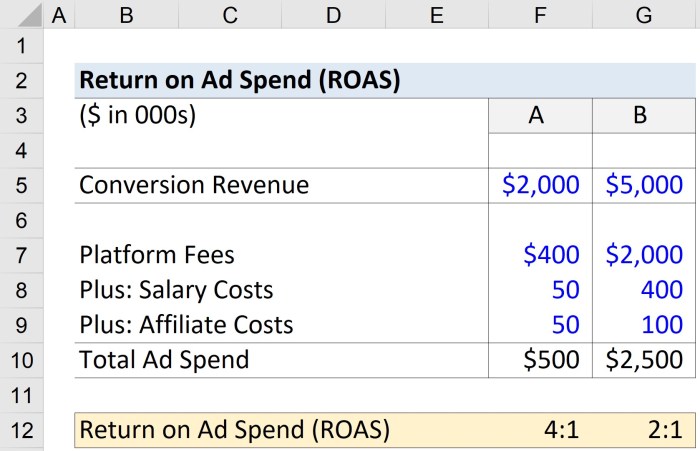Maximizing Return on Ad Spend is crucial for businesses looking to make the most out of their advertising investments. In this comprehensive guide, we’ll explore various strategies, tools, and techniques to help you boost your ROI and achieve greater success in your ad campaigns.
From understanding the basics of Return on Ad Spend to analyzing campaign performance, this guide will equip you with the knowledge and insights needed to excel in the competitive world of digital advertising.
Understanding Return on Ad Spend: Maximizing Return On Ad Spend

Return on Ad Spend (ROAS) is a marketing metric used to evaluate the revenue generated from advertising campaigns compared to the cost of those campaigns. It helps businesses understand how effectively their advertising dollars are being utilized.
Importance of Return on Ad Spend
Return on Ad Spend is crucial for businesses as it provides insights into the profitability of their marketing efforts. By calculating ROAS, companies can determine which advertising channels are most effective in driving revenue and adjust their strategies accordingly.
- ROAS = Revenue Generated from Ad Campaign / Cost of Ad Campaign
Calculation Examples
- Example 1: If an ad campaign generates $10,000 in revenue and costs $2,000 to run, the ROAS would be 5 ($10,000 / $2,000).
- Example 2: For an ad campaign that generates $15,000 in revenue with a cost of $3,000, the ROAS would be 5 as well ($15,000 / $3,000).
Strategies for Maximizing Return on Ad Spend
To maximize Return on Ad Spend, it is essential to implement effective strategies that can optimize advertising campaigns and ensure that every dollar spent generates a significant return. By utilizing various techniques and tools, businesses can improve the efficiency and effectiveness of their ad spend, ultimately leading to higher ROI.
1. Targeted Advertising
Targeted advertising involves reaching out to a specific audience based on demographics, interests, behaviors, or other criteria. By targeting the right audience, businesses can ensure that their ads are seen by individuals who are more likely to convert, thus increasing the chances of a higher return on ad spend.
2. A/B Testing
A/B testing is a method used to compare two versions of an ad to determine which one performs better. By testing different ad creatives, copy, or targeting strategies, businesses can identify what resonates best with their audience and optimize their campaigns for maximum ROI.
3. Conversion Rate Optimization
Conversion rate optimization focuses on improving the rate at which users take a desired action, such as making a purchase or signing up for a newsletter. By optimizing landing pages, ad copy, and calls-to-action, businesses can increase their conversion rates and ultimately maximize their return on ad spend.
4. Remarketing
Remarketing involves targeting users who have previously interacted with your website or ads. By retargeting these users with personalized ads, businesses can increase brand awareness, engagement, and conversions, leading to a higher return on ad spend.
5. Performance Monitoring and Optimization
Regularly monitoring the performance of ad campaigns and optimizing them based on data insights is crucial for maximizing return on ad spend. By analyzing key metrics such as click-through rates, conversion rates, and cost per acquisition, businesses can identify areas for improvement and make data-driven decisions to enhance their ad campaigns.
Tools and Technologies for Optimizing Ad Spend

In the digital marketing landscape, there are several tools and technologies available to help businesses optimize their ad spend and maximize return on investment. These tools provide valuable insights, automation, and analytics to make data-driven decisions for more effective advertising campaigns.
Popular Tools for Optimizing Ad Spend
- Google Ads: One of the most widely used platforms for online advertising, offering robust tools for targeting, ad placement, and performance tracking.
- Facebook Ads Manager: Ideal for social media advertising, providing detailed audience targeting options, ad creation tools, and performance metrics.
- Adobe Advertising Cloud: A comprehensive platform for managing and optimizing advertising campaigns across multiple channels, with a focus on data-driven insights.
Comparison of Ad Management Platforms
- Google Ads vs. Facebook Ads Manager: While Google Ads is great for search engine marketing, Facebook Ads Manager excels in social media advertising with advanced targeting options.
- Adobe Advertising Cloud vs. Google Ads: Adobe’s platform offers a more holistic approach to advertising, integrating data from various channels for a comprehensive view of ad performance.
Automation in Optimizing Ad Campaigns
Automation plays a crucial role in optimizing ad campaigns by streamlining processes, reducing manual tasks, and improving efficiency. Tools like automated bidding strategies, ad scheduling, and performance optimization algorithms help marketers make data-driven decisions in real-time for better returns on ad spend.
Measuring and Analyzing Ad Campaign Performance
In order to maximize Return on Ad Spend, it is crucial to measure and analyze the performance of ad campaigns. This allows businesses to understand what is working well and what needs improvement, ultimately leading to more effective advertising strategies.
Key Metrics for Analyzing Ad Campaign Performance
- Click-Through Rate (CTR): This metric measures the percentage of people who clicked on an ad after seeing it. A high CTR indicates that the ad is relevant and engaging to the target audience.
- Conversion Rate: The conversion rate shows the percentage of users who completed a desired action, such as making a purchase or signing up for a newsletter, after clicking on an ad. This metric helps determine the effectiveness of the ad in driving desired outcomes.
- Return on Investment (ROI): ROI calculates the revenue generated from an ad campaign compared to the cost of running the campaign. A positive ROI indicates that the campaign is profitable, while a negative ROI signals that adjustments are needed.
Best Practices for Analyzing Data to Improve Return on Ad Spend, Maximizing Return on Ad Spend
- Regularly Monitor and Track Metrics: Continuously monitor key metrics to identify trends and patterns in ad performance. This allows for timely adjustments to optimize campaigns.
- A/B Testing: Conduct A/B tests to compare different ad creatives, targeting strategies, or messaging to determine which variations yield the best results. This data-driven approach helps refine ad campaigns for maximum effectiveness.
- Data Segmentation: Segmenting data based on demographics, device type, or other variables can provide insights into which audience segments are most responsive to specific ads. This information can be used to tailor ad content to different audience groups for better engagement.





